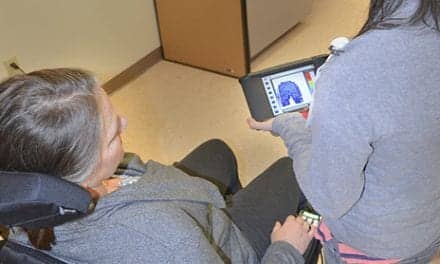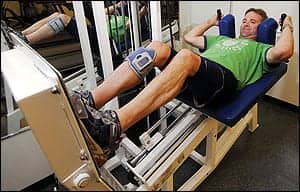The Department of Veterans Affairs’ Journal of Rehabilitation Research and Development (JRRD) has released Volume 45, Issue 7. Articles in the issue include—
Headaches among Operation Iraqi Freedom/Operation Enduring Freedom veterans with mild traumatic brain injury associated with exposures to explosions, (page 941)
Researchers evaluated the headache patterns of 126 veterans with mild TBI to determine whether those veterans with residual neurocognitive deficits would have a higher frequency of headaches and more severe headaches. Survey findings supported the hypotheses that veterans with residual neurocognitive deficits after TBI were more likely to have headaches, and that their headaches occurred more often and were more intense.
Quality of medical care provided to service members with combat-related limb amputations: Report of patient satisfaction, (page 953)
In a satisfaction survey of 158 service members who had lost one or more limbs from combat in Iraq and Afghanistan, researchers found that participants were most satisfied with their therapy, peer visitors, and medical care. Among participants with upper-limb amputations, those with amputations at shoulder level were most satisfied with their care but not significantly.
Prosthesis use in persons with lower- and upper-limb amputation, (page 961)
Given that phantom limb pain is a common experience after amputation, understanding the effect of this variable on prosthesis use is imperative. This study identified clinical and demographic factors related to prosthesis use in persons with upper- and lower-limb amputation and the effect of pain on prosthesis use.
Usage of tilt-in-space, recline, and elevation seating functions in natural environment of wheelchair users, (page 973)
This study examined the use of powered seating functions, including tilt-in-space, backrest recline, and seat elevation, among a group of 12 wheelchair users during their typical daily activities. Results showed that subjects chose to stay in tilted and reclined positions for significant portions of their day and spent little time in a fully upright position.
Effect of rear suspension and speed on seat forces and head accelerations experienced by manual wheelchair riders with spinal cord injury, (page 985)
A new study from the Rancho Los Amigos National Rehabilitation Center has found that vibration exposure may depend on suspension configuration, trunk muscle innervations, and speed, and that minimizing the forces transmitted to the rider is important for ride quality.
Feasibility of combining gait robot and multichannel functional electrical stimulation with intramuscular electrodes, (page 997)
This study extends the literature by demonstrating the feasibility of combining the gait robot and the multichannel FES-IM systems for gait training for subjects in the chronic phase after stroke. Study results show the combination of multichannel FES-IM and a gait robot was a feasible gait training method.
Selection of optimal muscle set for 16-channel standing neuroprosthesis, (page 1007)
Using a musculoskeletal model of the legs and trunk, researchers studied which muscles to target with a 16-channel standing neuroprosthesis in order to maximize the range of postures that can be statically maintained. The results show that the prime muscle targets should be the medial gastrocnemius, tibialis anterior, vastus lateralis, semimembranosus, gluteus maximus, gluteus medius, adductor magnus, and erector spinae. This set of 16 muscles supports 42% of the standing postures that are attainable by the nondisabled model.
Prevention of secondary stroke in VA: Role of OTs and PTs, (page 1019)
Department of Veterans Affairs/Department of Defense stroke rehabilitation guidelines indicate that secondary stroke prevention should be part of stroke rehabilitation. In this study, the authors surveyed rehabilitation therapists to assess whether they work with veterans to reduce the risk of a second stroke. The results indicate that that only half of the therapists were aware of the guidelines and only half discussed secondary stroke prevention and often referred patients to other health care providers for such information.
Content validity of a home-based person-environment interaction assessment tool for visually impaired adults, (page 1037)
This article describes a new assessment tool that helps professionals better understand the needs of visually impaired clients and their caregivers.
Validation of FIM-MDS crosswalk conversion algorithm, (page 1065)
While many hospitals use the Functional Independence Measure (FIM), skilled nursing homes use the Minimum Data Set (MDS) to evaluate patients. In this study, researchers performed a validation analysis of a crosswalk that converts FIM scores to MDS scores and vice versa in order to achieve score compatibility.
How humans walk: Bout duration, steps per bout, and rest duration, (page 1077)
Researchers documented the gait of daily living in 10 nondisabled employed adults to define walking bout duration, sequential step counts, and length of rest periods over a 2-week period. Based on this information, nondisabled individuals take many very short walking trips, stop often for short periods, and start walking again. Of all walking, 40% was less than 12 steps in a row and 75% was less than 40 steps in a row before they stopped walking. The purpose of this study was to inform rehabilitation strategies.
Effects of acute leg ischemia during cycling on oxygen and carbon dioxide stores, (page 1091)
While restricting blood flow to an exercising limb (ischemia), regular light exercises can increase exercise endurance. This study measured the changes in body oxygen (O2) and carbon dioxide (CO2) stores that occur during restriction of blood flow to exercising legs while cycling with thigh pressure cuffs inflated.
JRRD is a peer-reviewed journal sponsored by the Department of Veterans Affairs. Free print copies are available by e-mailing [email protected].
[Source: Newswise]



